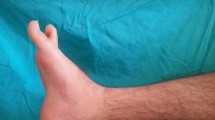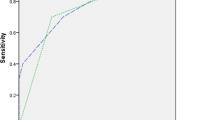Abstract
The controversy regarding the radiographic parameter which best represents the various deformities of clubfoot continues. The aim of our study was to clear up this controversy. Fifty surgically treated (soft-tissue release) congenital clubfeet were studied clinically using Laaveg and Ponseti score and radiologically using twelve different radiographic parameters in weight-bearing AP and lateral views. The talo-calcaneal angle (TCA) in AP and lateral view showed statistically significant correlation with the functional rating, but significant variation in the dimension of the angles among the different functional groups was found with AP angle only. The talo-first metatarsal angle in AP and lateral view averaged 10° and 19° respectively, and showed significant correlation with the functional rating. The talo-navicular subluxation in AP, the calcaneo–fifth metatarsal angle and the first–fifth metatarsal angle in lateral view did not show any significant correlation with function. Talo-calcaneal index averaged 44° in the clubfeet and showed significant correlation. The wide range of parameters representing each of the deformities gives a better radiological assessment of the clubfoot than any single parameter.
Résumé
Les paramètres radiographiques des pieds bots sont toujours très discutés. Le but de cette étude est de clarifier les controverses à ce propos. Matériel et méthode : 50 pieds bots opérés (libération interne) ont été étudiés sur le plan clinique en utilisant le score de Laaveg et Ponseti et sur le plan radiographique avec douze paramètres différents, les radiographies étant effectuées en charge de face et de profil. Résultat : l’angle Talo-calcanéen (TCA) de face et de profil est de façon significative associée aux résultats fonctionnels, l’angle talo-métatarsien (du premier métatarsien varie de 10 à 19°) et est également corrélé, de façon significative avec le score fonctionnel. La subluxation talo-naviculaire de face, l’angle calcaneo-métatarsien avec le 5ème méta et le premier méta ainsi que l’angle 1er et 5ème méta de profil ne sont pas corrélés avec le score fonctionnel. L’index talo-calcanéen est en moyenne de 44° et a une importante signification. En conclusion : l’association de ces différents paramètres permet d’avoir une meilleure appréciation radiologique du pied bot bien plus que l’utilisation d’un paramètre isolé.

Similar content being viewed by others
References
Beatson TR, Pearson JR (1966) A method of assessing correction in clubfeet. J Bone Joint Surg(Br) 48:40–50
Cohen-Sobel E, Caesli M, Giorgini R (1993) Longterm follow up of clubfoot surgery; analysis of 44 patients. J Foot Ankle Surg 32:411–423
Cooper DM, Dietz FR (1995) Treatment of idiopathic clubfoot. J Bone Joint Surg (Am) 77:1477–1489
DeRosa GP, Stepro D (1986) Results of postero medial release for the resistant clubfoot. J Paediatr Orthop 6(5):590–595
Fukuhara K, Schollmeier G, Uhthoff HK(1994) The Pathogensis of the clubfoot. J Bone Joint Surg (Br) 76:450–457
Haasbeek JF, Weight JG (1997) A comparison of long term results of posterior and comprehensive release in the treatment of clubfoot. J Paediatr Orthop 17(1):29–35
Handelsman JE, Soloman L (1973) The assessment of correction in clubfeet. SA Med J 13:1909–1911
Herbsthofer B, Eckardt A, Rompe JB, Kullmer K (1998) Significance of radiographic angle measurements in evaluation of congenital clubfoot. Arch Orthop Trauma Surg 17:324–329
Hutchins PM, Foster BK, Paterson DC, Cole EA (1985). Longterm results of early surgical release in clubfeet. J Bone Joint Surg (Br) 67:791–799
Laaveg SJ, Ponseti IV (1980) Longterm results of treatment of Congenital clubfoot. J Bone Joint Surg (Am) 62:23–31
Lau JH, Meyer LC, Lau HC (1989) Results of surgical treatment of talipes equinovarus congenita. Clin Orthop 248:219–226
Lehman WB (1980) Idiopathic talipes eqinovarus. In: Lehman WB, Torok G(eds) The clubfoot. JB Lippincott Company, Philadelphia
Main BJ, Crider RJ (1978) An analysis of residual deformity in clubfeet submitted to early operation. J Bone Joint Surg (Br) 60:536–543
Ono K, Hayashi H (1974) Residual deformity of treated congenital clubfoot. J Bone Joint Surg (Am) 56:1577–1585
Porat S, Kaplan L (1989) Critical analysis of results in clubfeet treated surgically along Norris Carroll approach: seven years of experince. J Paediatr Orthop 9(2):137–143
Ponseti LV, EL-Khoury GY, Ippolito E, Weinstein SL (1981) A radiographic study of skeletal deformities in treated clubfeet. Clin Orthop 160:30–42
Reimann I, Anderson HB (1974) Early surgical treatment of congenital clubfoot. Clin Orthop 102:200–206
Roye BD, Vitale MG, Gelijns AC, Roye DP Jr (2001) Patient based outcomes after clubfoot surgery. J Paediatr Orthop 21(1):42–49
Ryoppy S, Sairasnen H (1983) Neonatal operative treatment of clubfoot. J Bone Joint Surg (Br) 65:320–325
Simon GW (1978) A standard method for radiographic evaluation of clubfeet. Clin Orthop 135:107–118
Simon GW (1978) Analytical radiography and progressive approach in talipes equinovarus. Orthop Clin North Am 9:187–207
Thompson GH, Richardson AB, Westin GW (1982) Surgical Management of resistant congenital talipes equinovarus. J Bone Joint Surg (Am) 64:652–665
Turco VJ (1975) Resistant congenital clubfoot one stage posteromedial release with internal fixation. A follow up report of fifteen-year experience. J Bone Joint Surg (Am) 61:805–814
Uglow MG, Clarke NMP (2000). The functional outcome of staged surgery for the correction of talipes equinovarus. J Paediatr Orthop 20(4):517–523
Yamamoto H, Furuya K (1988) One stage postero medial release of congenital clubfoot. J Paediatr Orthop 8:590–595
Author information
Authors and Affiliations
Corresponding author
Rights and permissions
About this article
Cite this article
Prasad, P., Sen, R.K., Gill, S.S. et al. Clinico-radiological assessment and their correlation in clubfeet treated with postero-medial soft-tissue release. International Orthopaedics (SICO 33, 225–229 (2009). https://doi.org/10.1007/s00264-007-0448-0
Received:
Accepted:
Published:
Issue Date:
DOI: https://doi.org/10.1007/s00264-007-0448-0




